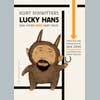 When I was a little girl, my mom—consummate feminist and literary mother par excellence—gave me Tatterhood and Other Tales, an anthology of feminist folk tales whose cover sported a soot-cheeked minx gamely beating back a gang of trolls with a wooden spoon. Published by the Feminist Press in 1978, Tatterhood was one of a slew of anthologies that emerged in the wake of the women’s rights movement to combat the patriarchal Brothers Grimm and Disney party line. But employing fairy tales for activist means was nothing new. In Weimer Germany, fairy-tale collections like the pungently titled Proletarischer Kindergarten (1921) were published by communists to critique the country’s turbulent capitalist ethos (and to recruit little comrades, no doubt). Such prominent Weimer artists as George Grosz often illustrated the books, but some, like Kurt Schwitters, also took to writing their own. If less aggressively political than his Dadaist peers, Schwitters was dedicated to upending societal norms and fracturing received artistic forms—a one-man aesthetic revolution that he called Merz; this, with his lifelong pique at bourgeois values, made the fairy-tale format well suited to his absurdist advances. Lucky Hans and Other Merz Fairy Tales, which translates twenty-eight of Schwitters’s tales into English for the first time, provides the satiric mix of the familiar and the fantastic with which fairy tales regularly operate. As with Schwitters’s celebrated collages and assemblages, however, the tales’ expected elements are shattered and reassembled into riotous, deeply weird wholes. Beautiful maidens, destitute peasants, kindly farmers, and anthropomorphized animals are subject to a brutality both heretical and bruisingly familiar. That the horrors of World War I and the Holocaust bookended the writing of these tales comes as no surprise. Narratives are reliably brought to savage conclusions: A peaceful man who must decapitate a body in order to free an enchanted virgin is tripped up by his own gentility and is himself sent to the gallows; a “good man” who lets a hungry insect sting him is then sucked dry by a swarm of mosquitoes. The end. In other stories, Schwitters disrupts the traditional structure by less bloodthirsty means. He cuts the folk timelessness of the narratives with sly meta-gambits: Hans and Grete debate the shattering of political ideals; another story opens with the observation that “transformations occur very often in fairy tales, and one thinks little about them.” Often, a disarmingly contemporary locution or fact breaks a tale’s dreamy veneer. In “Happiness,” a sister granted the wish of intelligence suddenly realizes her new smarts: “She knew just about everything. For instance, she knew that something would happen again in the Balkans, and she knew that peace conferences would only lead to the next war, and that pacifists were nothing more than strategic pawns for the Bolsheviks.” At other times, irrelevant asides spring up full grown. “By the way, Hildesheim is a wonderful old city” begins an odd paragraph in the middle of a parable about a man who wouldn’t stop growing (itself an allusion to the Weimar Republic’s runaway inflation). In such moments, Schwitters evokes no one so much as Swiss modernist Robert Walser—similarly a master of the short form and an adept juggler of shifting tonalities. While Schwitters sets the customary rhythms of fairy tales to this more experimentally lyric beat—particularly in the early stories, in which nonsense refrains and modernist syntax recall his Dadaist poetry and its propulsive, singsongy sense (his prose sometimes evokes Gertrude Stein’s “Rose is a rose is a rose is a rose” and his friend Hans Arp’s poems)—his narrative concerns are less anarchic than one might hope. He does not, for instance, dispense with moralizing altogether. Instead, he hammers home his obsession with happiness in story after story (his moral is the New Agey axiom that only in the absence of desire will happiness arrive) and repeatedly shows how groupthink can devolve into insanity (not so subtle stabs at the National Socialism that would in 1937 cause him to flee the country immediately after his work was included in the infamous “Degenerate Art” exhibition). Even so, the stories are disarmingly fresh, as they turn fairy tales’ draconian moral code, which we expect (and invariably delight in), on its head, showing such fantasy to be less fantastic and closer to home than any of us would like to admit.
|
